Guest Post by Margaret Brooker
With Additional Information by Elizabeth Young
January 7, 2023 Update: While we see this most often in male pigeons, it does happen with females too so I am updating the term to Underemployed Pigeon Syndrome (UPS).*
Margaret contacted Palomacy seeking marriage counseling assistance for her pigeons Emma and Ezra. Ezra had become very aggressive with Emma. This is something we see a lot. We call it Underemployed Male Pigeon Syndrome (UMPS)*. Pigeons are flock birds and they have a lot of social energy, especially the males. In a flock, even though married pigeons are very devoted to one another, the males flirt with all the females and show off to, trash talk and challenge all the males. They are busy most of the day. Feral city pigeons have even more to do looking for food all day. But a lone male pigeon living as a companion in a home, either with his mate or just his people, will often get bored, frustrated and angry. It happens all the time! Fortunately there are ways to help. Here’s Margaret’s story of Emma and Ezra with additional info from me along the way. EY
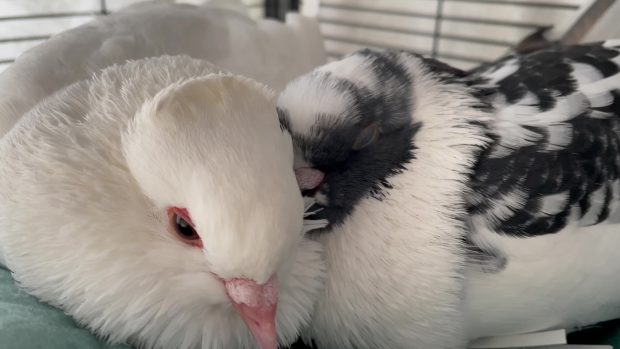
A quiet moment together
I adopted Emma and Ezra three years ago from Avian Underdogs, a pigeon and dove rescue in Orange County. When I first read Ezra’s story and saw his picture, I immediately fell for the little guy. He had been rescued a few months earlier with an injured wing, in downtown Los Angeles. His rescuer contacted Palomacy, who put her in touch with Avian Underdogs and paid for her bus fare to Orange County, since she didn’t have a car. She was the one who named him Ezra. I had only intended to adopt him, but when I got there, he had a choice of three lovely lady pigeons for a mate. Since pigeons are such social animals and mate for life, I knew it was the right thing to do to make sure he had a partner. I chose his favorite of the three, Emma, and adopted her as well.
I live in a small apartment, but work from home, so they have the run of my living room all day, with their open cage in a corner by a window. At first, they had a whirlwind romance, and Emma wasted no time in laying two lovely eggs, to be repeated each month. They both love to spend as much time as possible sitting on the eggs, with Emma sitting on them in the morning and Ezra in the afternoon. In the evening, it was always a constant battle for the privilege of sitting on the eggs, with the sweetest little wrestling matches to determine egg supremacy. Mostly Ezra would be the winner, so he would sit on them, and Emma would perch on the side of the nest, snuggled up beside him. They spent a large amount of time carefully preening each other. They loved those eggs more than anything else in the world.
It was like this until recently when some problems began to emerge. Ezra began to encourage Emma to abandon the nest earlier and earlier. When she laid the next two eggs, he would sit on them for longer periods during the day than he had previously and fight her when it was her turn. He seemed bored, but felt if he was going to be bored, he might as well be sitting on the eggs. The hardest time for him was when she laid the first egg, and he missed all the fun they had had exploring the apartment together. The honeymoon was over.
When he wouldn’t accept the new eggs and constantly fought with Emma, I contacted Palomacy. It turns out he has Underemployed Male Pigeon Syndrome (UMPS), as Palomacy calls it. Living with these little guys for three years, I am constantly being made aware of how intelligent they are. He was bored and needed a job.
This is what they recommended for him.
The first point is zero tolerance for him fighting with her. If he does, he goes straight into his pet crate in a quiet place for a timeout. I am still working on this, and it may take some time, but consistency is the key.
EY: We have seen great success with time-outs though it can take many repetitions. (We sometimes use it to stop a persistent bully in an aviary too.) Implement this approach when you have the time to observe and interrupt the bullying consistently. When the aggressor attacks, say, [Name], NO and scoop them up and into a waiting pet carrier or crate. Leave them in for five minutes to start and then let them out. Watch and repeat. You can extend the timeouts to 30 minutes or even a couple of hours if needed. It will likely feel like it’s not working but stay with it and it nearly always does. (The longest I’ve had to do this is for a week.) Ultimately the aggressor makes the decision to stop attacking and, once they do, we’ve found that it holds. We have former bullies living peacefully beside their prior target safely. (I recognize that this is not a positive reinforcement training approach and welcome input on the subject. These next tips are positive.)
The other recommendations are the fun part, keeping them both engaged and happy, without becoming bored.
Foraging for their food – Since they spend a large amount of their time in the wild foraging for food, it helps to make them work harder for their food if they can forage. They have a small seed bowl in their cage, but a larger tray at the other end of the apartment. I also used some shells I found at the beach for foraging, hiding some of their favorite seeds under a group of shells. They both really enjoy this. Ezra can flip over the shells faster than I can place the seeds. Emma will pick up the shells one by one, but he’s an impatient little bird and can knock over several at once with a beak swipe.
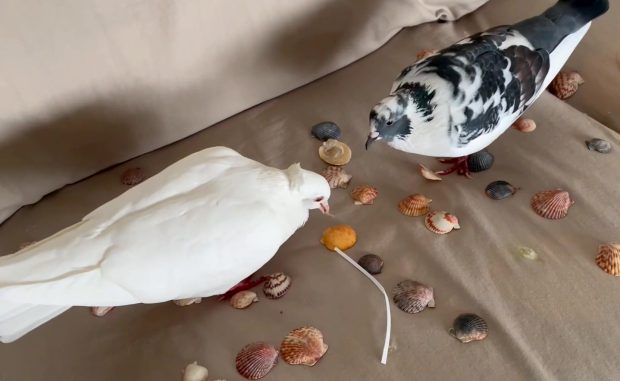
Hunting for seed under shells
EY: I love Margaret’s creativity with the shell game! There are lots of good ideas out there for foraging (mostly designed for parrots but some will work or can be modified for pigeons). One approach we often recommend is using a big fake turf mat or a snuffle mat dog feeder as your pigeons’ food dish so that they have to forage for every piece. Be sure that you only use the old fashioned rubber fake turf (not the fancy looks & feels like grass cellophane kind) so that your birds don’t foreage and ingest and become impacted with the fake grass. Use the same caution with snuffle mats or any fabric- no long fibered material as it can be preened and ingested and cause severe problems. Use only short fiber fabrics, think velvet or velour.
Stroller or carrier for walks – I have a small pet carrier with mesh sides I’ve been taking them out for a walk, one at a time. So far Emma has enjoyed this more than Ezra, but she got to see some other pigeons while he only saw squirrels, so I will keep doing this each week. Emma saw a large flock of pigeons, and really enjoyed the sound of their cooing.
EY: We highly recommend taking your pigeons for safe outings and it is especially valuable for underemployed male pigeons! Even though he may only be riding in a pet carrier on an errand or in a stroller or bird back pack and not physically active, it really wears them out- mentally and emotionally – and gives the mate a break while he’s away, too. Please always keep your pet pigeon safely secured. Riding on your shoulder or otherwise unenclosed is super dangerous for them.
Socks and other toys – This helps to channel some of his male pigeon energy. Ezra had always loved a good tussle with my sleeve, But I was recommended to use a sock over my hand as a toy. This made him go ballistic, biting and wing slapping it with great gusto. Now I try to engage him in a game a few times a day. He can distinguish the difference between the sock and my unarmed hand, if I show him my hand afterwards, he isn’t aggressive. Emma has learned the sock game by watching us, but her idea of fighting it is to gently grasp it with her beak and give it a soft shake.
EY: Play fighting is wonderful for your underemployed male pigeon! And it won’t make them more aggressive but rather the opposite. They need to burn that energy and play-fighting them with a puppet or sock on your hand or plush toy is great for them. (Short fibers only!) We also recommend creating a punching bag toy for your underemployed pigeon by hanging a plush toy where he can play fight anytime. (Use only a single strand of ribbon or string to hang it- NO LOOPS! Any loops in your pigeons’ area are a stranglulation risk.)
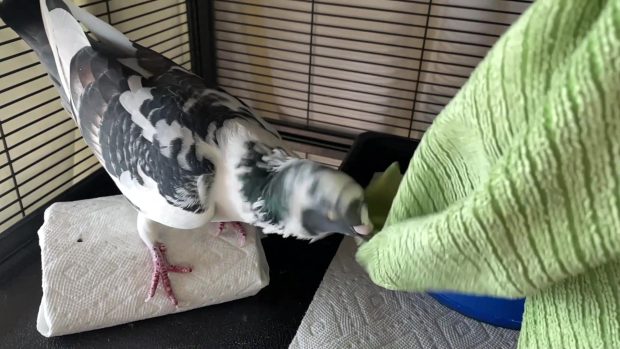
Showing the towel who’s boss
Bonus: Pigeon Marian Boxing Her Flamingo!
Pigeon TV – Being flock animals, they really enjoy the company of other pigeons. I have tried to show them videos of other pigeons on my iPad. At first Ezra was very interested and would peck the screen, but he became bored when he couldn’t find the other pigeons behind the iPad. Emma only showed a mild curiosity, but I have noticed she does enjoy the sound of other birds, particularly the Birds Sounds channel on Pandora.
EY: Male pigeons especially enjoy being able to show off in nice big mirrors and can burn off a lot of excess energy cooing and dancing at themselves. Move mirrors around so that he gets the fun of looking for and discovering them. While mirrors may or may not be good for some birds, they are great for pigeons (and they have been proven to self-recognize). Pigeons also appreciate watching videos, television (Sponge Bob is one of our adopted pigeon’s favorite), interacting via FaceTime or with two way pet cameras or monitors (especially helpful for when you’re away). If yours isn’t much impressed, try another channel or approach.
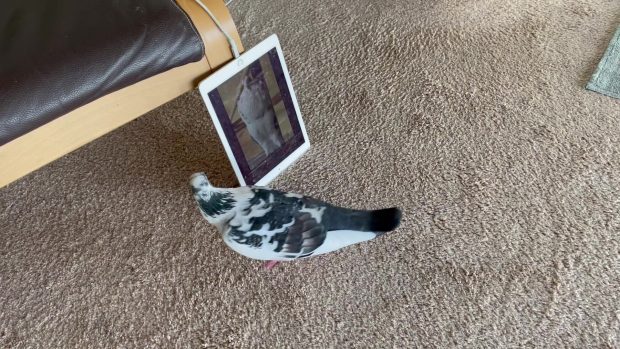
Where did that pigeon go?
Building the nest – This is a major event in their lives. Ezra is the principal nest builder, although Emma does occasionally help. I use food grade carboard, cut into twig sized pieces. When it comes time to build the nest Ezra can go overboard, running all over the apartment in search of good twigs. Its important to make him really work for those twigs, so I hide and scatter them in various places. He can spend hours at a time on this, and it does make him very happy.
EY: Palomacy suggests putting out a variety of different types of nesting materials if you can (long pine needles, long grass, thin twigs, zip ties in different colors, paper shreds, etc. etc.) because they all seem to have their preferences and it’s fun to see them express theirs. In addition to different materials, you can also use different lengths with some being to short and others too long to give them the satisfaction of finding just the right stuff. And like Margaret says, make them work for it. Put the nesting materials as far away from the nest as possible so that they spend lots of energy looking for and trundling it back to the nest. And don’t limit how much you put out. Some pigeons are very industrious and will build huge nests given the materials.
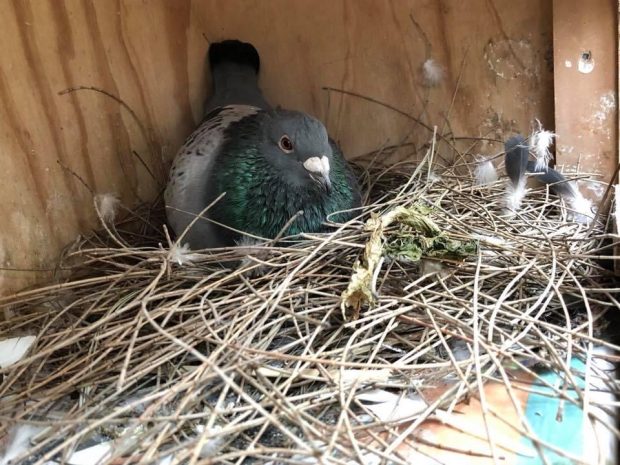
Amelio likes to build a big nest
So, are these new engagements working? It’s hard to tell because they can’t directly tell me how they feel, but they do seem happier. Ezra did accept the latest eggs and is spending time tending them. They both are napping less, and Ezra is spending a little less time on the nest. Emma has been doing more exploring outside the cage by herself. I am going to keep trying to find more ways to challenge and occupy them, and in the process we should all have more fun.
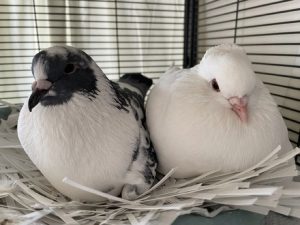 Margaret Brooker lives in Marina del Rey and works from home in software development, with her feathered co-workers, Emma and Ezra. Birds have always held a special place in her heart. She has previously worked as a volunteer with aquatic birds at International Bird Rescue in San Pedro. Emma and Ezra have taught her how rescue pigeons can make such loving, quirky and intelligent companions. You can see Emma and Ezra in action at Twitter: @emmaandezra1
Margaret Brooker lives in Marina del Rey and works from home in software development, with her feathered co-workers, Emma and Ezra. Birds have always held a special place in her heart. She has previously worked as a volunteer with aquatic birds at International Bird Rescue in San Pedro. Emma and Ezra have taught her how rescue pigeons can make such loving, quirky and intelligent companions. You can see Emma and Ezra in action at Twitter: @emmaandezra1
See more on the topic at Listen to Your Birds (Avian Underemployment)

